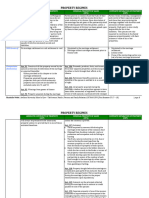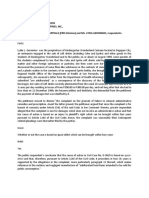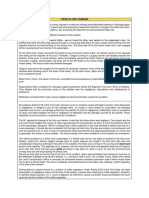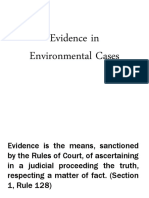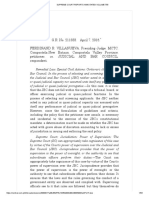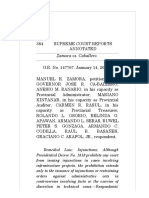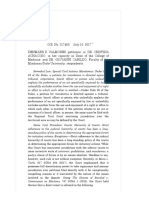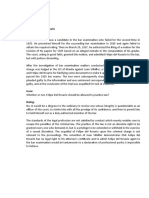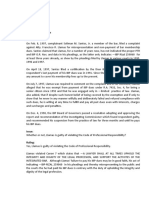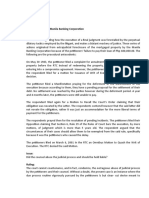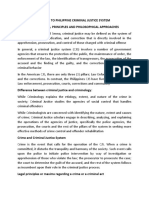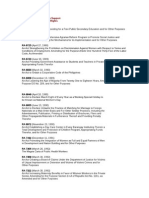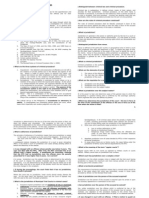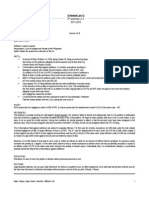Proximate Cause
Proximate Cause
Uploaded by
Lu CasCopyright:
Available Formats
Proximate Cause
Proximate Cause
Uploaded by
Lu CasOriginal Description:
Original Title
Copyright
Available Formats
Share this document
Did you find this document useful?
Is this content inappropriate?
Copyright:
Available Formats
Proximate Cause
Proximate Cause
Uploaded by
Lu CasCopyright:
Available Formats
Proximate Cause.
In order to win a personal injury action, a plaintiff
must prove that a defendant's negligence caused the plaintiff's injuries.
... In other words, proximate cause exists when the injury is the
foreseeable result of the negligence. For example, a truck driver
negligently crashes into a house.
Proximate Cause
In order to win a personal injury action, a plaintiff must prove that a
defendant's negligence caused the plaintiff's injuries. In negligence law,
there are two types of causation:
(1) "cause in fact"; and
(2) "proximate cause."
The plaintiff must prove both types of causation.
A negligent act is the proximate cause of a plaintiff's injury if the
injury is the natural and probable result of the act. In other words,
proximate cause exists when the injury is the foreseeable result of the
negligence. For example, a truck driver negligently crashes into a
house. Due to the impact, a piece of plaster falls from the ceiling of a
house and onto the homeowner, injuring him. The truck driver's
negligence is the proximate cause of the homeowner's injury because
injury to an occupant of the house is a foreseeable result of crashing a
truck into the house. Note that the particular injury and the manner
in which the injury occurs do not have to be foreseeable in order to
constitute proximate cause. Crashing into the house is the proximate
cause of the homeowner's injury because it was foreseeable that some
sort of injury would occur. A second example: a bicycle rider
negligently runs into a pedestrian. The pedestrian is uninjured but
stunned. He walks around the block to clear his head, and he is
injured by a rabid dog. In this scenario, the bicycle rider's negligence is
not the proximate cause of the pedestrian's injury because being
attacked by a dog is not the foreseeable result of a bicycle accident.
Concurrent Causes
When two or more negligent acts contribute to a plaintiff's injuries,
those acts are called "concurrent causes." For example, a pedestrian
stands on a street corner. A bicycle rider negligently runs into the
pedestrian, knocking him into the street. As a truck swerves to avoid
the pedestrian, a piano falls from the truck and onto the pedestrian,
injuring him. Before the accident, the truck driver negligently failed to
secure the piano to the truck. The negligent acts of the bicycle rider
and the truck driver are concurrent causes because both acts
contributed to the pedestrian's injuries.
When there are concurrent causes, both negligent actors will be liable
for the plaintiff's injury only if each negligent act was a substantial
factor in causing the injury. In the above example, the pedestrian's
injury would not have occurred if not for the negligent acts of both the
bicycle rider and the truck driver. Therefore, the negligent acts of both
the bicycle rider and the truck driver were substantial factors in
causing the pedestrian's injury, and both of them would be liable for
damages in the pedestrian's personal injury action.
Intervening and Superseding Causes
An "intervening cause" or "superseding cause" breaks the chain of
causation between a negligent act and a plaintiff's injury. For example,
a truck driver negligently crashes into a house. The impact breaks a
window but does not injure the homeowner. Later that night, a burglar
crawls through the broken window and assaults the homeowner. The
homeowner files a personal injury action against the truck driver to
recover for the injuries that were inflicted by the burglar. In this case,
the burglar's conduct was not a foreseeable result of the truck driver's
negligence. Therefore, the burglar's conduct was an intervening or
superseding cause. The truck driver's negligence was not the proximate
cause of the homeowner's injuries, so the homeowner cannot recover
damages from the truck driver in a personal injury action.
You might also like
- FEGARIDO VS. ALMARINA G.R. No. 240066Document2 pagesFEGARIDO VS. ALMARINA G.R. No. 240066Jessel PalermoNo ratings yet
- Property RegimesDocument6 pagesProperty RegimesNikki Mayor-OngNo ratings yet
- BFP SOPonFireandArsonInvestigationDocument9 pagesBFP SOPonFireandArsonInvestigationhailglee192563% (8)
- Coca-Cola Vs CADocument2 pagesCoca-Cola Vs CAjdg jdgNo ratings yet
- zck43 Rough Justice The International Criminal Court in A World of Power Politics PDFDocument313 pageszck43 Rough Justice The International Criminal Court in A World of Power Politics PDFSpiro Maliqi100% (2)
- Latonio vs. McGeroge Food IndustriesDocument2 pagesLatonio vs. McGeroge Food IndustriesRyo100% (1)
- Torts and Damages 1st Take ReviewerDocument8 pagesTorts and Damages 1st Take ReviewerAntonJohnVincentFrias67% (3)
- 2 The Ilocos Norte Electric Co Vs CADocument2 pages2 The Ilocos Norte Electric Co Vs CALeo Felicilda100% (1)
- 001 DIGESTED Amado Picart Vs Frank Smith - G.R. No. L-12219Document4 pages001 DIGESTED Amado Picart Vs Frank Smith - G.R. No. L-12219Paul ToguayNo ratings yet
- Great Pacific Life Vs CADocument2 pagesGreat Pacific Life Vs CADann ThrowerNo ratings yet
- Quasi DelictDocument5 pagesQuasi DelictRosalia L. Completano LptNo ratings yet
- Direct Tortfeasor Art. 2176, CCDocument5 pagesDirect Tortfeasor Art. 2176, CCCARLO JOSE BACTOLNo ratings yet
- Proximate CauseDocument3 pagesProximate CauseJunyvil Tumbaga100% (1)
- Municipality of San Juan v. CADocument2 pagesMunicipality of San Juan v. CAkim_santos_20No ratings yet
- Delsan Transport Lines Vs C A Construction GR 156034Document5 pagesDelsan Transport Lines Vs C A Construction GR 156034Princess GalangNo ratings yet
- Limbona vs. Mangelin (G.R. No. 80391) - DigestDocument5 pagesLimbona vs. Mangelin (G.R. No. 80391) - DigestTep DomingoNo ratings yet
- Efficient Intervening CauseDocument2 pagesEfficient Intervening CauseKatherine AlombroNo ratings yet
- BUSTAMANTE V CA - DigestDocument1 pageBUSTAMANTE V CA - DigestKate GaroNo ratings yet
- Damnum Absque Injuria DoctrineDocument2 pagesDamnum Absque Injuria Doctrineaj salazarNo ratings yet
- Philippine National Railways v. BruntyDocument2 pagesPhilippine National Railways v. BruntyEarl Anthony ArceNo ratings yet
- Affidavit of Death Due To Vehicle Accident - For Insurance ClaimDocument1 pageAffidavit of Death Due To Vehicle Accident - For Insurance ClaimJulPadayaoNo ratings yet
- Civil Liability Arising From CrimeDocument2 pagesCivil Liability Arising From CrimeYNNA DERAYNo ratings yet
- G.R. No. 92087: Torts and Damages Case Digest: Fernando V. CA (1992)Document2 pagesG.R. No. 92087: Torts and Damages Case Digest: Fernando V. CA (1992)Alexander Dimalipos100% (1)
- Guillang Vs Bedania and SilvaDocument2 pagesGuillang Vs Bedania and Silvajdg jdgNo ratings yet
- Reviewer in LGC..Document923 pagesReviewer in LGC..Carmela Paola R. DumlaoNo ratings yet
- Tison vs. Sps. PomasinDocument21 pagesTison vs. Sps. PomasinyanaNo ratings yet
- 1Document41 pages1Arrianne ObiasNo ratings yet
- CASESDocument32 pagesCASESAlyssa joy TorioNo ratings yet
- Case Digest Guilang v. BedaniaDocument2 pagesCase Digest Guilang v. BedaniamagenNo ratings yet
- Distraint V LevtDocument1 pageDistraint V LevtRomela Eleria GasesNo ratings yet
- Nikko Hotel Manila vs. ReyesDocument5 pagesNikko Hotel Manila vs. Reyesistefifay100% (1)
- Cango V Manila RoadDocument1 pageCango V Manila RoadVincent BernardoNo ratings yet
- Doctrine of State Continuity: October 2, 2018Document3 pagesDoctrine of State Continuity: October 2, 2018Japoy Regodon EsquilloNo ratings yet
- Efficient Intervening Cause: Definition and ConceptDocument3 pagesEfficient Intervening Cause: Definition and ConceptgleeNo ratings yet
- Presumption of NegligenceDocument5 pagesPresumption of NegligenceCasa AlveldaNo ratings yet
- CD - 49. Bengued Electric Cooperative Inc. vs. Court of Appeals Et Al., G.R No. 12736 23 Dec 1999Document1 pageCD - 49. Bengued Electric Cooperative Inc. vs. Court of Appeals Et Al., G.R No. 12736 23 Dec 1999MykaNo ratings yet
- Evidence in Environmental CasesDocument34 pagesEvidence in Environmental CasesShiela MagnoNo ratings yet
- (B32) LAW 104 - Picart v. SmithDocument3 pages(B32) LAW 104 - Picart v. SmithmNo ratings yet
- Torts Case Digest Baliwag V CADocument1 pageTorts Case Digest Baliwag V CAKristine Joy TumbagaNo ratings yet
- Donald Mead vs. Hon. Manuel Argel G.R. No. L-41958 July 20, 1982 FactsDocument1 pageDonald Mead vs. Hon. Manuel Argel G.R. No. L-41958 July 20, 1982 FactsLuz Celine CabadingNo ratings yet
- Siacor vs. GigantanaDocument2 pagesSiacor vs. GigantanaJaneen ZamudioNo ratings yet
- Natural FruitsDocument2 pagesNatural FruitsHazel GacayanNo ratings yet
- Torts and Damages Case Digest: Pedro Elcano, Et Al., V. Reginal Hill Et Al. (1977)Document2 pagesTorts and Damages Case Digest: Pedro Elcano, Et Al., V. Reginal Hill Et Al. (1977)jobelle barcellanoNo ratings yet
- American Express International, Inc. VS Noel CorderoDocument5 pagesAmerican Express International, Inc. VS Noel Corderovincent remolacioNo ratings yet
- Incomplete/Partial Defense: Doctrine of Contributory NegligenceDocument3 pagesIncomplete/Partial Defense: Doctrine of Contributory NegligenceMaria Recheille Banac KinazoNo ratings yet
- Sps Jayme v. ApostolDocument2 pagesSps Jayme v. ApostolIvan Luzuriaga100% (1)
- PP Vs CRISTINA SAMSON-self DefenseDocument8 pagesPP Vs CRISTINA SAMSON-self DefenseRothea SimonNo ratings yet
- LGU Liability For Injuries Caused by Defective Public WorksDocument2 pagesLGU Liability For Injuries Caused by Defective Public Worksyurets929No ratings yet
- Saligumba Vs PalanogDocument3 pagesSaligumba Vs PalanogJerome LeañoNo ratings yet
- Fernando v. CADocument2 pagesFernando v. CAAmber Anca100% (1)
- PTB Bonfiacio CruzDocument12 pagesPTB Bonfiacio CruzHarry PotterNo ratings yet
- Professional Services, Inc. vs. Natividad and Enrique Agana GR No. 126297Document2 pagesProfessional Services, Inc. vs. Natividad and Enrique Agana GR No. 126297Edz Votefornoymar Del RosarioNo ratings yet
- Pilipinas Bank vs. CADocument1 pagePilipinas Bank vs. CAJolynne Anne GaticaNo ratings yet
- Torts Digest Us Vs JuanilloDocument1 pageTorts Digest Us Vs JuanilloCamille GrandeNo ratings yet
- Torts Digests FinalsDocument89 pagesTorts Digests FinalsAnne sherly OdevilasNo ratings yet
- Possessor of AnimalDocument2 pagesPossessor of AnimalCamille BritanicoNo ratings yet
- Layugan V IACDocument2 pagesLayugan V IACLou Angelique HeruelaNo ratings yet
- B.F. Metal (Corporation) v. LomotanDocument3 pagesB.F. Metal (Corporation) v. LomotanAndrew AmbrayNo ratings yet
- MANILA ELECTRIC COMPANY v. NORDEC PHILIPPINESDocument2 pagesMANILA ELECTRIC COMPANY v. NORDEC PHILIPPINESBeau Bautista100% (1)
- Torts Batch 3 Case DigestDocument31 pagesTorts Batch 3 Case DigestPaulo VillarinNo ratings yet
- Mahogany, Federal Express and Eternal Case DigestsDocument4 pagesMahogany, Federal Express and Eternal Case DigestsLemuel Angelo M. EleccionNo ratings yet
- 045 Dy Teban Trading V ChingDocument6 pages045 Dy Teban Trading V ChingArnel MangilimanNo ratings yet
- Villanueva Vs Judicial & Bar Council, 755 SCRA 182, G.R. No. 211833, April 7, 2015Document63 pagesVillanueva Vs Judicial & Bar Council, 755 SCRA 182, G.R. No. 211833, April 7, 2015Gi NoNo ratings yet
- Zamora Vs CaballeroDocument30 pagesZamora Vs CaballeroLu CasNo ratings yet
- Re 1989 ElectionsDocument3 pagesRe 1989 ElectionsLu CasNo ratings yet
- Valmores Vs Achacoso and Cabildo, 831 SCRA 442, G.R. No. 217453, July 19, 2017Document28 pagesValmores Vs Achacoso and Cabildo, 831 SCRA 442, G.R. No. 217453, July 19, 2017Lu CasNo ratings yet
- 019GMA Network Vs Commission On Elections, 734 SCRA 88, G.R. No. 205357, September 2, 2014Document165 pages019GMA Network Vs Commission On Elections, 734 SCRA 88, G.R. No. 205357, September 2, 2014Lu CasNo ratings yet
- US Vs Ney and BosqueDocument2 pagesUS Vs Ney and BosqueLu CasNo ratings yet
- In Re Felipe Del Rosario FactsDocument1 pageIn Re Felipe Del Rosario FactsLu CasNo ratings yet
- Garcia Vs LopezDocument2 pagesGarcia Vs LopezLu CasNo ratings yet
- Laput Vs RemotigueDocument2 pagesLaput Vs RemotigueLu CasNo ratings yet
- Reyes Vs ChiongDocument2 pagesReyes Vs ChiongLu Cas100% (1)
- Barandon Jr. Vs Ferrer Sr.Document3 pagesBarandon Jr. Vs Ferrer Sr.Lu Cas100% (1)
- Petition For Disbarment of Telesforo A. DiaoDocument2 pagesPetition For Disbarment of Telesforo A. DiaoLu CasNo ratings yet
- Santos Jr. Vs LlamasDocument2 pagesSantos Jr. Vs LlamasLu CasNo ratings yet
- Zaguirre Vs CastilloDocument2 pagesZaguirre Vs CastilloLu CasNo ratings yet
- In Re Investigation of Angel Parazo For Alleged Leakage of Questions in Some Subjects in The 1948 Bar Examinations FactsDocument2 pagesIn Re Investigation of Angel Parazo For Alleged Leakage of Questions in Some Subjects in The 1948 Bar Examinations FactsLu CasNo ratings yet
- Leda Vs TabangDocument2 pagesLeda Vs TabangLu Cas0% (1)
- Saburnido Vs MadronoDocument2 pagesSaburnido Vs MadronoLu CasNo ratings yet
- Dallong-Galicinao Vs Atty. Virgil R. Castro, A.C. No. 6396, October 25, 2005Document2 pagesDallong-Galicinao Vs Atty. Virgil R. Castro, A.C. No. 6396, October 25, 2005Lu Cas100% (3)
- Javier Vs CornejoDocument2 pagesJavier Vs CornejoLu CasNo ratings yet
- Alitagtag Vs GarciaDocument1 pageAlitagtag Vs GarciaLu CasNo ratings yet
- Cesar L. Lantoria Vs Atty. Irineo L. Bunyi FactsDocument3 pagesCesar L. Lantoria Vs Atty. Irineo L. Bunyi FactsLu CasNo ratings yet
- Macias Vs Benjamin B. MaligDocument3 pagesMacias Vs Benjamin B. MaligLu CasNo ratings yet
- Spouses Aguilar Vs Manila Banking Corporation FactsDocument2 pagesSpouses Aguilar Vs Manila Banking Corporation FactsLu Cas100% (1)
- Business CombinationsDocument9 pagesBusiness CombinationsLu CasNo ratings yet
- Accounting For Marketable SecuritiesDocument18 pagesAccounting For Marketable SecuritiesLu CasNo ratings yet
- Receivables and Revenue RecognitionDocument21 pagesReceivables and Revenue RecognitionLu CasNo ratings yet
- Debit CreditDocument33 pagesDebit CreditaamritaaNo ratings yet
- Long-Lived Assets: 15.511 Corporate Accounting Summer 2004 Professor SP KothariDocument24 pagesLong-Lived Assets: 15.511 Corporate Accounting Summer 2004 Professor SP KothariLu CasNo ratings yet
- Mexican Border Ambushes 1110Document6 pagesMexican Border Ambushes 1110ihatethis999No ratings yet
- CLJ 1 - PCJSDocument4 pagesCLJ 1 - PCJSSay DoradoNo ratings yet
- United States v. Manuel Covarrubias-Garcia, 16 F.3d 417, 10th Cir. (1994)Document4 pagesUnited States v. Manuel Covarrubias-Garcia, 16 F.3d 417, 10th Cir. (1994)Scribd Government DocsNo ratings yet
- Insurance Policy & PremiumDocument33 pagesInsurance Policy & PremiumCarlos Ryan RabangNo ratings yet
- 1 List of Philippine Laws in Support For WOMENSDocument8 pages1 List of Philippine Laws in Support For WOMENSNylinad Etnerfacir ObmilNo ratings yet
- Criminal Procedure Midterms Reviewer 2016Document25 pagesCriminal Procedure Midterms Reviewer 2016Kim Ecarma50% (2)
- UK's UN Third Committee PoemDocument2 pagesUK's UN Third Committee PoemUK Mission to the UNNo ratings yet
- Law Abiding CitizenDocument1 pageLaw Abiding CitizenPhoebe Eliz Julao0% (1)
- CRIMPRO Reviewer Rule 110-114Document15 pagesCRIMPRO Reviewer Rule 110-114Meet MeatNo ratings yet
- RA 6969 Toxic Substances and Hazardous and Nuclear Wastes Control ActDocument8 pagesRA 6969 Toxic Substances and Hazardous and Nuclear Wastes Control ActMaryStefanieNo ratings yet
- Congo V Belgium PDFDocument30 pagesCongo V Belgium PDFipmanaseNo ratings yet
- Case Should Be Cited As Follows: (1972) H.C.D. N. 27Document535 pagesCase Should Be Cited As Follows: (1972) H.C.D. N. 27Godfrey G. TeshaNo ratings yet
- Slavery in The ChocolateIndustry ChocolateIndustryDocument3 pagesSlavery in The ChocolateIndustry ChocolateIndustryaali1219No ratings yet
- ICE Rajkot Material PDF - Constitution of IndiaDocument22 pagesICE Rajkot Material PDF - Constitution of IndiaViralNo ratings yet
- Hector Guillen-Martinez IndictmentDocument15 pagesHector Guillen-Martinez IndictmentEmily BabayNo ratings yet
- PLACEMENT TEST Α΄ ΛυκείουDocument3 pagesPLACEMENT TEST Α΄ ΛυκείουaverofioNo ratings yet
- LASAM VsDocument1 pageLASAM VsLisa RobbinsNo ratings yet
- New DS160 - Print ApplicationDocument6 pagesNew DS160 - Print ApplicationTrần Thanh Minh ThưNo ratings yet
- Lamera V CADocument2 pagesLamera V CAIhna Alyssa Marie SantosNo ratings yet
- United States v. Moises Benmuhar, United States of America v. William Pacheco Nieves, 658 F.2d 14, 1st Cir. (1981)Document10 pagesUnited States v. Moises Benmuhar, United States of America v. William Pacheco Nieves, 658 F.2d 14, 1st Cir. (1981)Scribd Government DocsNo ratings yet
- 1Document68 pages1Rizky ArifNo ratings yet
- Answering A Civil Complaint in CaliforniaDocument3 pagesAnswering A Civil Complaint in CaliforniaStan BurmanNo ratings yet
- Indemnity & Limitation of IndemnityDocument2 pagesIndemnity & Limitation of IndemnityPallavi SupehiaNo ratings yet
- DEA History Part2Document79 pagesDEA History Part2Tarso Araujo100% (1)
- MIGUEL PASCUAL, Plaintiff-Appellant,: Ledesma, Sumulong & Quintos For Appellant. Alberto Barretto For AppelleeDocument5 pagesMIGUEL PASCUAL, Plaintiff-Appellant,: Ledesma, Sumulong & Quintos For Appellant. Alberto Barretto For AppelleeHanna PentiñoNo ratings yet
- Waller v. Quarterman - Document No. 2Document2 pagesWaller v. Quarterman - Document No. 2Justia.comNo ratings yet
- Aproject Report On Forensic Accounting and AuditingDocument42 pagesAproject Report On Forensic Accounting and AuditingMolineSit100% (1)
- PRESIDENTIAL DECREE No. 1619Document2 pagesPRESIDENTIAL DECREE No. 1619Carlito Quimada Jr.No ratings yet

